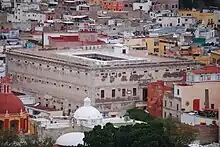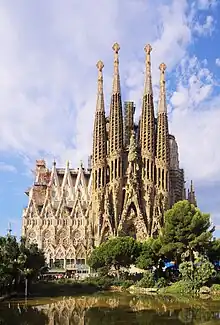An alhóndiga (from Medieval Spanish alfóndiga, in turn from Arabic al-fondaq, this in turn from Greek pandocheion, lit.: "welcome all") or almudí, almudín, alholí, public house or neighbors' market was formerly an establishment where grain was sold, bought and even stored, whose purpose was to help the neighbors and mainly the farmers in times of shortage. It is historically equivalent or derived from the caravanserais (or funduqs) of the Muslim world.[1][2]
In the Kingdom of Aragon, Catalan consulates were established around the Mediterranean to control business. In such Consolats de Mar the alfòndec (same etymology as alhóndiga) was an important part of the ensemble, usually comprising storage, hospitality and church services.
The public almudíes were establishments managed by the city councils where all those who introduced any kind of grain to sell were obliged to carry them with the same object. The almudí was composed of large and spacious warehouses or markets in which various types of grain were conveniently placed. It was open during the day and to this deposit often came many bodies and individuals who wanted to acquire a certain amount of cereals for their needs. Each competitor or holder of grains satisfied by rights a price for each quantity of wheat, rye, millet, bean, corn, vicia faba, barley and oats which it kept.
Currently companies and cooperatives dedicated to the agricultural sector use the term alhóndiga in their social denominations, especially those of Andalusia and Murcia.[3][4]
The function of these alhóndigas, in Andalusia and Murcia, is to unify the supply and demand of horticultural products, where the farmers take their products to the alhóndiga and this is responsible for auctioning them through a dynamic auction on the low in exchange for a commission.[5]
 Cambra Vieja del Trigo in Ademuz, Valencian Community
Cambra Vieja del Trigo in Ademuz, Valencian Community Alhóndiga in Ágreda, Castile and León
Alhóndiga in Ágreda, Castile and León The Alhóndiga in Ávila (demolished).
The Alhóndiga in Ávila (demolished).
 Alhóndiga Municipal Cultural Center in Bilbao. Former municipal wineteca reconverted in "Cultural Center Iñaki Azkuna Zentroa".
Alhóndiga Municipal Cultural Center in Bilbao. Former municipal wineteca reconverted in "Cultural Center Iñaki Azkuna Zentroa". Former Almudí in Cuenca, Spain
Former Almudí in Cuenca, Spain Corral del Carbón, former alhóndiga in Granada
Corral del Carbón, former alhóndiga in Granada
 Courtyard of the former Almudín de Xàtiva (Valencian Community)
Courtyard of the former Almudín de Xàtiva (Valencian Community)
 Palacio del Almudí, Murcia
Palacio del Almudí, Murcia Former Alhóndiga in Segovia, today Municipal Archive
Former Alhóndiga in Segovia, today Municipal Archive The Almudín in Valencia.
The Almudín in Valencia..JPG.webp) The former Alhóndiga del Pan in Zamora
The former Alhóndiga del Pan in Zamora
References
- ↑ Nachouane, Nour Eddine; Knidiri, Aicha (2019). "Les fondouks d'artisanat de Marrakech: de l'immatérialité du patrimoine à sa mise en scène touristique". Hespéris-Tamuda. LIV (1): 285–303.
- ↑ Jiménez Roldán, María del Carmen (2019). "Del funduq a la alhóndiga: un espacio entre el emirato nazarí y el reino de Granada (s. XV-XVI)". Al-Qantara. 40 (2): 315–354.
- ↑ "Alhóndiga Agrisel".
- ↑ "Alhóndiga La Unión".
- ↑ "Prices of Almerian alhóndigas". Archived from the original on 2016-10-08.
- Guía de Zaragoza, 1860.
